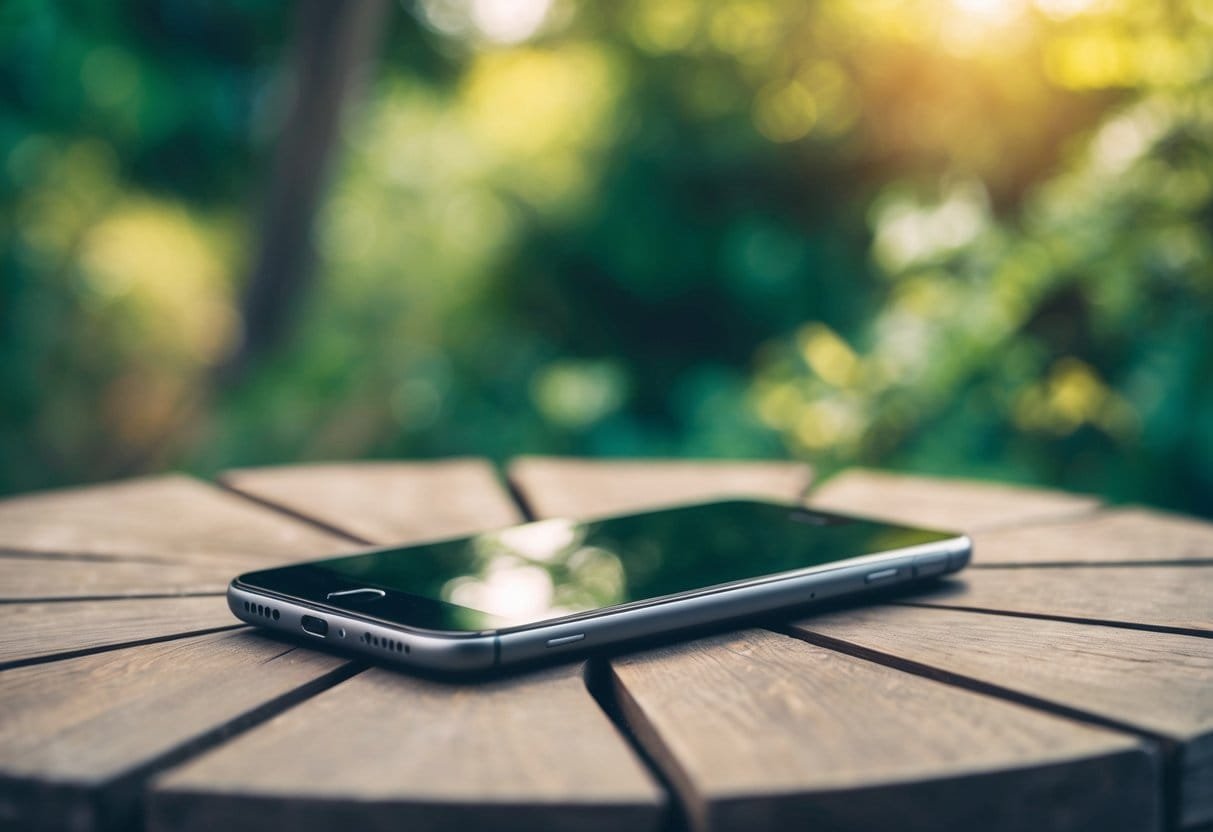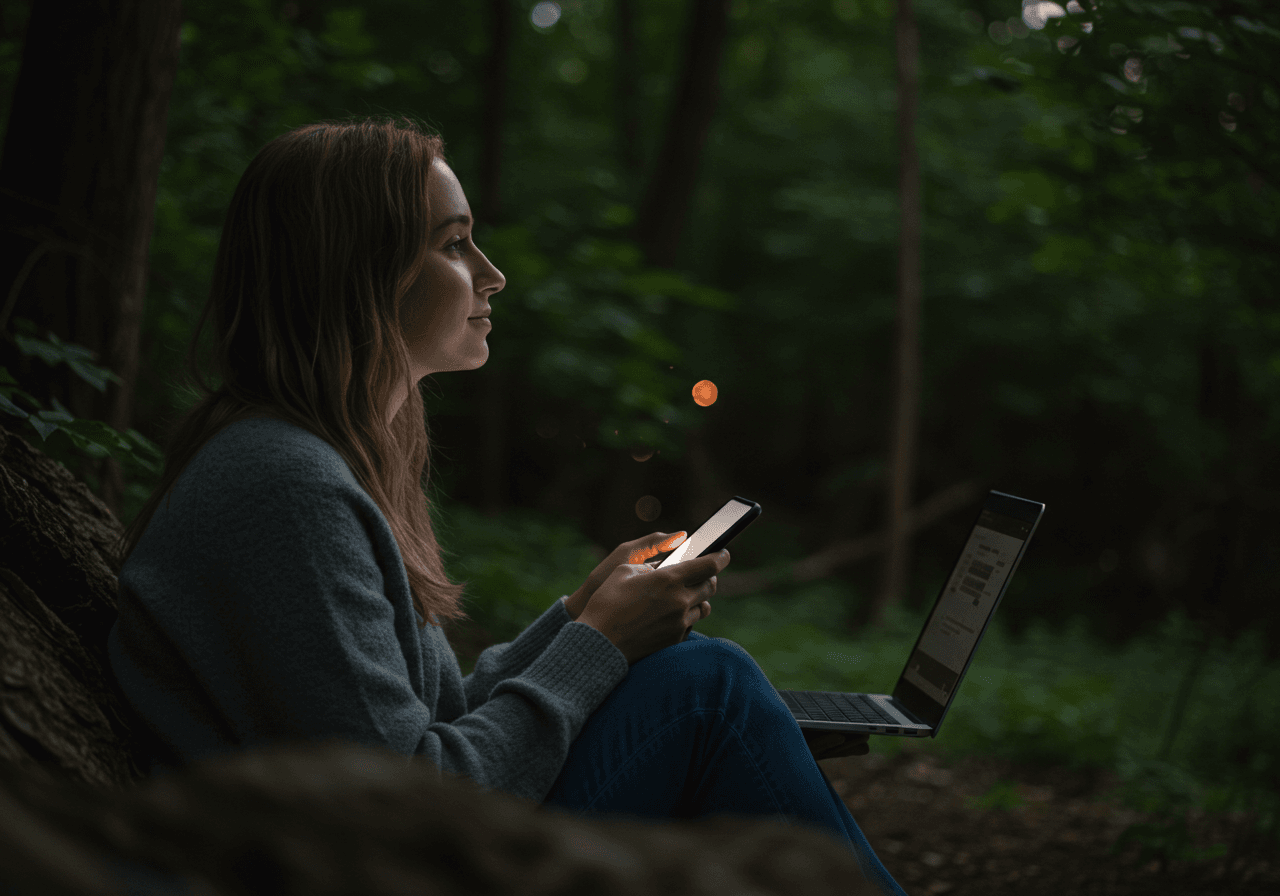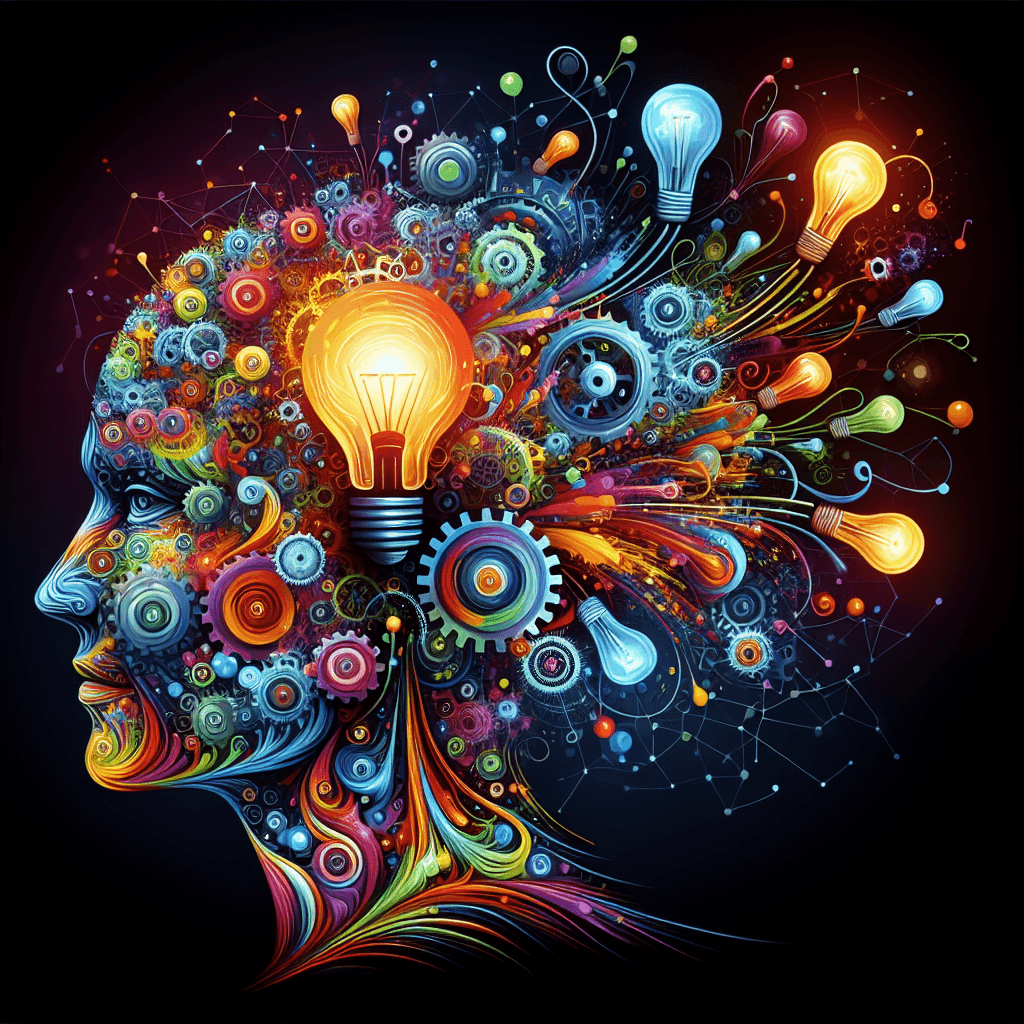Table of Contents
In a world where screens dominate much of your waking life, taking control of your digital habits is crucial.
Digital detoxing allows you to reclaim your time and attention, offering a chance to focus on what genuinely matters. This practice involves mindful screen usage without completely disconnecting from the technology that keeps you connected to the world.

The relationship between screen time and your well-being is more significant than you might realize.
By reducing your digital consumption, you can improve both your physical and mental health. Simple strategies can be implemented to limit distractions while maintaining essential connectivity, ensuring a healthy balance in an increasingly digital landscape.
Key Takeaways
- Digital detox helps reclaim time and attention.
- Reducing screen time improves well-being.
- Strategies exist to limit digital consumption effectively.
Understanding Digital Detox

Digital detox is an intentional process of disengaging from digital devices, aiming to improve mental health by alleviating symptoms like anxiety and depression. It promotes better attention spans and sleep quality by reducing digital overload in daily life.
Defining Digital Detox
Digital detox involves a deliberate and temporary disengagement from digital devices such as smartphones, tablets, and computers.
This practice allows you to step back from the constant notifications and digital interactions that can consume your attention and energy. By setting boundaries and reducing screen time, you create space for face-to-face interactions, hobbies, and relaxation. A digital detox is not about completely eliminating technology but rather about establishing a healthier balance that acknowledges the benefits of technology while minimizing its negative impact on your well-being.
The Impact of Digital Devices on Mental Health
The pervasive use of digital devices can significantly impact your mental health.
Constant connectivity leads to increased anxiety and contributes to higher levels of stress. This digital overload may also result in shortened attention spans and challenges with focus. Moreover, the blue light emitted by screens can disrupt sleep quality, further affecting mental health. Studies have linked excessive screen time with symptoms of depression, as the continuous stream of information and social comparisons can foster negative emotions. By recognizing and addressing these impacts, you can actively work towards a healthier digital life.
Engaging in regular digital detox sessions can help alleviate mental stress and improve overall well-being.
The Relationship Between Screen Time and Well-Being

Screen time impacts both your personal relationships and your physiological health. It is crucial to understand how excessive use of screens can lead to stress and poor sleep patterns, affecting your overall well-being.
Effects of Screen Time on Personal Relationships
Excessive screen time can affect your personal relationships by reducing the quality and quantity of face-to-face interactions.
When you spend more time on screens, it can lead to decreased attentiveness and engagement with those around you. This is particularly noticeable during social gatherings, where the allure of digital devices can divert your focus from meaningful conversations.
Continuous digital distraction may create a sense of isolation, as you might find yourself more connected to virtual communities than to those physically present. This change in interaction can lead to misunderstandings and a weakening of important social bonds. By becoming more aware of your screen usage, you can work to foster better communication and stronger personal connections.
How Screen Time Affects Sleep Patterns and Stress Levels
Screen time, especially before bedtime, can seriously impact your sleep patterns.
The blue light emitted by screens interferes with the production of melatonin, a hormone responsible for regulating sleep. This disruption can result in difficulty falling asleep and reduced sleep quality, leading to increased stress levels.
Chronic stress from lack of sleep can affect multiple aspects of your life, from your mood to your physical health. The combination of poor sleep and heightened stress can decrease your overall well-being and productivity.
Establishing screen-free routines, particularly in the evening, can help improve both your sleep quality and stress management.
Strategies for Reducing Digital Consumption

This section outlines effective methods to manage your digital habits by establishing clear boundaries and practicing mindful technology use. Implementing these strategies can lead to reduced stress and enhance your overall well-being.
Setting Boundaries with Digital Devices
Establish tech-free zones in your home to create spaces where digital devices are not allowed. This could include bedrooms or dining areas, fostering an environment focused on relaxation and personal interactions.
Setting time limits for device usage, especially during meals and before bedtime, can significantly reduce digital consumption and improve your sleep quality.
Use apps and settings on your devices to manage screen time effectively. Enable features that automatically limit app usage after a certain period, helping you maintain a healthier relationship with technology.
Regularly review and adjust these limits to ensure they suit your evolving lifestyle and needs.
Mindful Consumption of Technology
Practice mindful consumption by being conscious of how and why you use digital devices.
Before grabbing your phone or logging on, question whether it’s necessary or if it’s merely a habit. Focus on engaging with content that adds value to your life rather than mindlessly scrolling.
Schedule specific times for checking messages and social media. This method, often referred to as batching notifications, encourages purposeful digital interactions and minimizes distractions.
Curate digital environments by decluttering apps and unsubscribing from non-essential feeds, reducing mental overload and maintaining a more focused digital lifestyle.
Practical Tips for Implementing a Digital Detox

Creating a digital detox strategy involves making deliberate changes in your daily routine to reduce digital interference. Establishing tech-free zones and engaging in offline activities are effective ways to renew focus and spur creativity.
Creating a Tech-Free Zone
Designate specific areas in your living space where technology is off-limits. This approach helps minimize digital interruptions, allowing you to concentrate better on your thoughts and tasks at hand.
A tech-free zone could be as small as a corner in a room or as large as an entire room. Ensure these areas are comfortable and inviting to encourage frequent use.
You could use shelves to hold books or art supplies, replacing devices with items that stimulate your senses and intellectual curiosity. In these zones, you may also introduce houseplants or calming scents like lavender to enhance relaxation and mental clarity.
Establishing tech-free times, such as during meals or an hour before bed, can further reinforce the habit.
By creating these spaces, you cultivate a sanctuary for focus and enhanced mental clarity.
Offline Activities to Enhance Focus and Creativity
Engaging in offline activities is key to reawakening your creativity and improving concentration.
Consider activities that absorb your attention and require active participation, such as painting, writing, or playing a musical instrument. These activities not only provide a break from screens but also nourish your creative spirit.
Group activities like board games or sports can foster social interaction, combining physical engagement with fun. Solo pursuits such as gardening or cooking can be equally rewarding, offering moments of tranquility and a chance to connect with the physical world.
Set aside regular time for these pursuits to consistently refresh your mind and sustain your creative thinking. Engaging in these offline activities regularly boosts your problem-solving skills and invigorates your mind.
Maintaining Connectivity While Limiting Distractions
Maintaining a balance between being connected and minimizing distractions is essential. This involves prioritizing genuine connections over excessive screen time and creating boundaries for technology use.
Balancing Virtual Interactions and Real-Life Connections
To ensure meaningful interactions, emphasize quality over quantity. Allocate specific times daily for checking messages and engaging in virtual interactions.
This helps maintain digital boundaries while safeguarding time for personal relationships.
Integrate social media and virtual communication as tools to enhance relationships, not replace them. Plan regular face-to-face meetups with friends and family. Use video calls for important discussions, strengthening connections without letting technology overshadow real-life bonds.
Prioritize relationships by setting aside device-free times.
Managing Notifications and Digital Interruptions
Turning off non-essential notifications significantly reduces distractions. Customize your device settings to receive alerts only from important contacts or apps.
This tactical approach helps maintain attention, especially during critical work or family time.
Utilize batch processing for handling emails and messages, dedicating specific times to address these tasks. This method ensures timely communication without constant disruptions.
Leverage apps that help manage notification settings more effectively. These tools assist in identifying unnecessary alerts, streamlining your digital experience.
Promote focus by keeping devices silent during meetings or family gatherings. This ensures that important moments are uninterrupted, maintaining the balance between connectivity and presence in personal and professional spaces.
Improving Physical and Mental Well-Being
Taking a break from digital devices can significantly enhance both your mental and physical health. By reducing screen time, you are likely to experience reduced stress levels and increased mental clarity, while incorporating physical activities can further boost your overall well-being.
Enhancing Mental Clarity and Well-Being Through Disconnection
Experiencing a digital detox can substantially aid in boosting your mental clarity and well-being.
Disconnecting allows your mind to rest and reset from constant digital stimuli. This break helps reduce stress and anxiety, providing space for self-reflection and improving focus. You might notice heightened attention and a greater sense of calm as mental clutter decreases.
By limiting exposure to digital noise, you can enhance sleep quality, which is crucial for mental recovery.
Engaging more in real-world interactions and activities can foster a deeper sense of presence and connection. Prioritizing these digital-free periods can contribute to maintaining a balanced and healthier mental state, benefiting your daily life and interactions.
The Role of Exercise and Physical Activity in a Digital Detox
Physical activity plays a crucial role during a digital detox.
Engaging in regular exercise enhances physical health and supports mental well-being by releasing endorphins, which are natural mood lifters.
Whether it’s short walks, yoga, or more intensive workouts, integrating movement into your day helps mitigate stress and anxiety levels.
Not only does exercise provide these mental health benefits, but it also breaks the daily routine of sitting with devices, encouraging you to embrace more active pursuits.
Replacing screen time with outdoor activities can improve both your physical stamina and mental resilience. By staying active, you gain more energy and maintain a balanced approach to disconnecting from digital distractions.
Sustaining a Healthy Balance in the Digital Age
In the digital age, maintaining a healthy balance involves practicing mindfulness and creating structured daily routines.
Focusing on these aspects can enhance your digital well-being by encouraging personal growth and improving your quality of life.
Cultivating Mindfulness and Personal Growth
Mindfulness can significantly impact your quality of life in the digital era.
Being aware of your technology usage allows you to make more intentional decisions, avoiding unnecessary distractions.
Set specific times to check your devices, such as checking emails only at designated times, instead of reacting instantly.
Practicing mindfulness helps in reducing stress caused by constant notifications.
Engage in activities promoting personal growth, like reading or meditation, that don’t involve screens.
Mindful activities reinforce a sense of balance, encouraging you to live in the moment. Implementing these practices boosts mental clarity and enhances overall productivity.
Establishing Daily Routines for a Balanced Digital Lifestyle
Creating daily routines is essential for a balanced digital lifestyle.
Start with setting boundaries, like no devices during meals, to cultivate a healthier digital interaction.
Designate device-free zones in your home to limit screen time and promote face-to-face connections.
Incorporate productivity-enhancing habits such as task lists or timers to monitor and limit work-related device use.
Allocate specific periods for digital activities and ensure time is reserved for non-digital hobbies, such as walking or exercising.
Structuring routines this way fosters a healthier balance between technology and other important aspects of life, supporting better overall digital well-being.
Frequently Asked Questions
Implementing a digital detox can transform your lifestyle by enhancing relationships, boosting productivity, and improving sleep quality. Recognizing the signs that it’s time for a detox is crucial to address excessive screen time.
How do you successfully implement a digital detox in a busy lifestyle?
To execute a digital detox within a hectic schedule, start by setting specific goals like limiting social media use or scheduling screen-free periods.
Consistency is key, so create a routine that incorporates frequent breaks from technology.
You can also designate certain hours or areas in your home as screen-free zones.
What are the clear signs that someone needs to start a digital detox?
Common signs indicating the need for a digital detox include difficulty concentrating, disrupted sleep patterns, or feeling overwhelmed by notifications.
If you’re consistently prioritizing screen time over face-to-face interactions, it’s likely time to reassess your digital habits and take proactive steps to cut back.
Can a digital detox improve personal relationships, and if so, how?
A digital detox can significantly improve personal relationships by encouraging more meaningful interactions.
By reducing time spent on screens, you can actively engage and communicate with those around you, strengthening bonds and fostering deeper connections.
This intentional shift in focus allows for better quality time with family and friends.
In what ways can a digital detox contribute to increased productivity at work?
Reducing screen time can enhance work productivity by minimizing distractions and improving focus.
A structured digital detox encourages deeper concentration on tasks, leads to fewer interruptions, and helps in managing stress effectively.
This can result in more efficient time management and higher-quality work outputs.
How does screen time affect sleep, and can a digital detox help?
Excessive screen time before bed is linked to sleep disturbances due to blue light exposure, which interferes with melatonin production.
Implementing a digital detox that includes screen curfews or reducing evening screen time can improve sleep quality. It encourages healthier sleep patterns, allowing you to wake up refreshed and more alert.
Ready to try a digital detox?
Explore these resources:
- “Digital Minimalism: Choosing a Focused Life in a Noisy World” by Cal Newport: Provides a philosophy and practical steps for decluttering your digital life and reclaiming focus.
- “Irresistible: The Rise of Addictive Technology and the Business of Keeping Us Hooked” by Adam Alter: Explores the persuasive design of technology and its addictive potential.
- “The Shallows: What the Internet Is Doing to Our Brains” by Nicholas Carr: Examines the neurological impact of constant internet use on our cognitive abilities.
- “How to Break Up with Your Phone: The 30-Day Plan to Take Back Your Life” by Catherine Price: A practical guide with a step-by-step plan to reduce phone dependence and build healthier habits.
- “Alone Together: Why We Expect More from Technology and Less from Each Other” by Sherry Turkle: Explores the complex relationship between humans and technology and its impact on connection.




